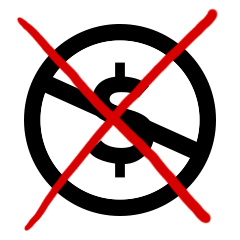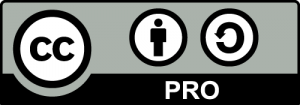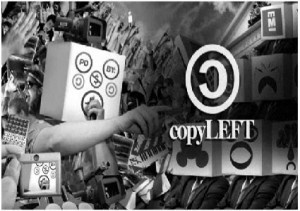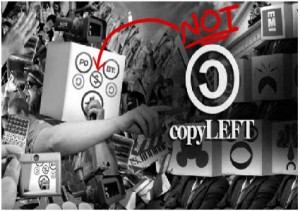
About a year and a half ago I released my film Sita Sings the Blues under a Creative Commons Attribution-ShareAlike license. That license allows truly free distribution, including commercial use, as long as the free license remains in place. But my experience is that most people see the words “Creative Commons” and simply assume the license is Non-Commercial — because the majority of Creative Commons licenses they’ve seen elsewhere have been Non-Commercial.
This is a real problem. Some artists have re-released Sita remixes under Creative Commons Non-Commercial licenses. Many bloggers and journalists assume the non-commercial restrictions, even when the license is correctly named:
The film was made available under a Creative Commons Attribution-Share Alike License, allowing third parties to share the creative content for non-commercial purposes freely as long as the author of the content is attributed as the creator of the work. –from Frontline, India’s National Magazine
Initially I tried to explain what “ShareAlike” means to CC-NC remixers of “Sita”, and asked them to please switch to ShareAlike, per the terms of the ShareAlike license under which I released it. I felt like an ass; I don’t want to be a licensing cop. After a while, mis-identifications of the project’s license became so widespread I gave up trying to correct them. “Creative Commons” means “Non-Commercial” to most people. Fighting it is a sisyphean task.
So I’m stuck with a branding problem. As long as I use any Creative Commons license, most people will think it prohibits commercial use. Hardly anyone seems to register, let alone understand, CC-SA. Worse, those who do notice the ShareAlike marker combine it with Non-Commercial restrictions on their re-releases, which compounds the confusion (CC-NC-SA is the worst license I can imagine).
ShareAlike is an imperfect solution to copyright restrictions, as it imposes one restriction of its own: a restriction against imposing any further restrictions. It’s an attempt to use copyright against itself. As long as we live in a world wherein everything is copyrighted by default, I will use ShareAlike or some other Copyleft equivalent to attempt to maintain a “copyright-free zone” around my works. In a better world, there would be no automatic copyright and thus no need for me to use any license at all. Should that Utopia come about, I will remove all licenses from all my work. Meanwhile I attempt to limit other peoples’ freedom to limit other peoples’ freedom.
It would be nice if the Creative Commons organization did something to address this branding confusion. We suggested re-branding ShareAlike licenses as CC-PRO, but given that Creative Commons’ largest constituency is users of Non-Commercial licenses, it seems unlikely (but not impossible!) that they would distinguish their true Copyleft license with a “pro” brand.

It would also be nice if everyone, including representatives of Creative Commons, referred to their licenses by their names, instead of just “Creative Commons.” “Thank you for using a Creative Commons license,” they tell me. You’re welcome; I would thank you for calling it a ShareAlike license. Almost every journalist refers to all 7 licenses as simply “Creative Commons licenses.” And so in the popular imagination, my ShareAlike license is no different from a Non-Commercial, No-Derivatives license.
This branding crisis came to a head recently when the Canadian Broadcasting Corporation banned all Creative Commons licensed music in its shows:
The issue with our use of Creative Commons music is that a lot of our content is readily available on a multitude of platforms, some of which are deemed to be ‘commercial’ in nature (e.g. streaming with pre-roll ads, or pay for download on iTunes) and currently the vast majority of the music available under a Creative Commons license prohibits commercial use.
In order to ensure that we continue to be in line with current Canadian copyright laws, and given the lack of a wide range of music that has a Creative Commons license allowing for commercial use, we made a decision to use music from our production library in our podcasts as this music has the proper usage rights attached. link
The Creative Commons organization wants to get the CBC to separate out its different licenses. They could help by calling their licenses by their different names. If the Creative Commons organization itself calls them all “Creative Commons Licenses,” how can they expect others to distinguish the licenses from each other?
Perhaps Creative Commons should only offer the Non-Commercial/No Derivatives licenses everyone associates with the name. Then they could create a new name/brand for their Free licenses. FreeCommons? CultureSource? CopyLove?
Meanwhile, I’m wondering how to clearly communicate my work is COPYLEFT. In addition to the CC-SA license, if there’s room I write “COPYLEFT, ALL WRONGS REVERSED”. Unfortunately, the term “Copyleft” is growing increasingly meaningless as well. For example, Brett Gaylor’s mostly excellent film RIP: A Remix Manifesto gets a lot of things right, but it misunderstands and misuses the term “copyleft”. Copyleft actually means this:
the right to distribute copies and modified versions of a work and requiring that the same rights be preserved in modified versions of the work. In other words, copyleft is a general method for making a program (or other work) free, and requiring all modified and extended versions of the program to be free as well. -Wikipedia
But in RIP it means this:

See that dollar sign with the slash in it? That means Non-Commercial restrictions, which are most definitely NOT Copyleft.

Anyone introduced to the word “Copyleft” in that film won’t know what Copyleft actually means in terms of licenses.
I need a license that people understand. I’m tempted by the WTFPL but I would have to fork it to add a copyleft provision. The Do Whatever You Want And Don’t Restrict Others From Doing Whatever They Want Public License? WTFDROPL?
Are there any other useable Copyleft licenses out there that aren’t associated with non-commercial restrictions? I’m open to suggestions.

You are beginning to recognise that CC is fucked. It is not a principled neutralisation of copyright as the GPL is.
I suggest:
1) Covenant to your audience (the public) that you will NEVER prosecute copyright against anyone’s cultural liberty.
2) Provide a concise, human readable, copyleft license:
“Naturally, you are free to take any liberties you wish with my published work. However, should I ever be granted the privilege of constraining your liberty then I constrain you thus: the liberties you take may not be withheld from those to whom you give my work (or your combined/derivative work), who you must similarly constrain.”
This ‘concice copyleft license’ is implicitly compatible with CC-SA and GPL (even GFDL). It’s also pretty much compatible with WTFDROPL.
Yes, this is an old confusion, even for copyleft in software there is a FAQ about it: http://www.gnu.org/licenses/gpl-faq.html#NoMilitary
a human psychology problem.
This strip seemed appropriate (the comic has been doing a whole series on Open Source lately): http://notinventedhe.re/on/2010-10-20.
This is a growing problem. People say “It’s creative commons!” like it is actually informative. The only thing that you do get out of a statement like that is that you are allowed to share that work (non-modified!) to your friends.
“Non-commercial use” is so undefined, not even Creative Commons dare to define it. That means no-one should use works under NC, ever. Because what if the license-holder accused you of “gaining a economic advantage”?
Creative Commons really ought to remove the “Creative” word from the ND and NC licenses. The goal of Creative Commons may not be Free Culture, but they could at least make their branding clearer.
How about Free Art Licence?
It looks like it permits usage exactly like you ask for(?).
http://artlibre.org/licence/lal/en
So, what was wrong with my comment of an hour or so ago – that precludes its publication?
CC license names are pretty systematic and self-explaining. If people can hardly remember their names now, how hard it would be with new meaningless names.
Another aspect of the confusion is what ‘non-commercial’ actually means and where the line is drawn. CC released a study that demonstrated that.
Personally, I prefer the ‘non-commercial’ for my work because it leaves it open to licensing should someone do it for profit. And those that have requested my stuff for non-profits, educational books, etc, have gotten free licenses. It happens, believe it or not, for little folk who don’t make full movies and only write/take pictures. 🙂
However, I also honor licenses that do not have the ‘non-commercial’ clause if and when I do remix.
That said, I do not agree that the various licenses need to be renamed just because the Canadians Broadcasting Corporation doesn’t understand them. Creative Commons Licensing is ubiquitous.
As far as CopyLeft – that’s a Stallman term. Be careful when using Stallman terms. He loves correcting people on the finer points of his verbage (and I know that, personally).
Well, I think David is right : The free art license is a very good choice. It’s very close from the CC-by-sa (quite the same in fact). It’s more simple to understand (in my opinion). This license is completly copyleft : built by the people from “copyleft attitude” and most of them (all?) are french, just like me. And for that reason, it’s surely the best choice 😉
Hello Nina,
The people at safecreative.org are trying to build a worldwide record of intelectual property holders, and they wisely rebranded CC-licenses so they can explain to the visitor more clearly what the license means.
You can take a look here: http://www.safecreative.org
Regards,
Copyleft licensing worked for software primarily because:
a) Licensing legalese can be as convoluted as software (though law!=logic) and coders could discern the copyleft principle.
b) Software is fundamentally derivative – if the original author isn’t modifying it, another one is.
For the rest of culture, artists and the artistic process are often a little bit more organic in nature.
Until copyright (and patent) is abolished there are only those two things the artist can do: attach something to the art that persuades the recipient they won’t end up like Emmanuel Nimley if they point their iPhone at it, and ideally make it clear that this isn’t a one-off act of mercenary expediency, that the artist is indeed committed to liberating their audience (will neither sue, nor enable them to be sued, for taking liberties prohibited by copyright).
I should add that this is one of the reasons why I created http://fclogo.org – a way of indicating that a work of art was ‘free culture’ – no ifs or buts. Moreover, even the logo itself is free culture, just an ideogram free to evolve to the taste of each artist that touched it. The fclogo site is even a wiki. Just how free can you get?
>Crosbie. I had a look at fclogo.org and it looks like a honest and good cause but there are a few questions I have.
Is there some licence attached to the logo? I didn’t find any at the wiki. If not, how is the logo used? – If placed in created content, do one have to add an creative licence as well to make it legally right? If only a logo with the 4 points you’ve listed intended I doubt it will be legally alright. Worst case someone uses the logo for work, then sSomeone else uses that work and redistribute it. First person then claims the fc-logo is not legally binding and that an ordinary ©-licence applies, then sues second person for distributing the work.
It work be an easy task to formally create a free licence of your 4 points. Or attaching your logo to an already existing licence, like the free art one I mentioned before.
Also, would you accept evolved versions of the logo? I think that if it is to be used it has to look a bit more polished.
David, culture cannot be free if we insist that people be lawyers when they engage with it.
Innocent people are already being taken to the cleaners (and I do not classify copyright infringement as incriminating, as constituting guilt).
The free culture logo is not a legal instrument, but an expression of the artist. No artist can ever hand on heart swear that their work is 100% original, devoid of all possible influence, and so dissimilar from any other work as to have zero risk of liability.
The logo says “Enough! I shall not sue, nor enable anyone else to sue, any other artist or member of my audience for acts they would be at liberty to do, but for copyright.”
As for the logo itself, yes, let a thousand flowers bloom! Polish it, gild it, paint it. You are at liberty.
I understand your motives for attempting to control all the derivatives of your work to make sure they are also shared in a similar way. While a noble desire, the problem is arising because you are still seeking to control. The only path to true happiness is to give up control completely and let the work go where it will.
After a long struggle to control his content, Leo Babauta released all claims to any form of copyright. He has one of the top blogs in the world, makes tons of money, and has none of the stress of trying to control his work anymore.
Put your work in the public domain. Free yourself from the desire to control. As you can see, people will do what they want anyway.
Create, and then let go.
I agree with David and iza, why not use the Free Art License?
http://artlibre.org/licence/lal/en
(in French: “Licence Art Libre”)
French makes the distinction between “libre” (free as in “free speech”)
and “gratuit” (free as in “free beer”).
It really has this “copyleft spirit” and has been thought like a
GNU GPL but for art works.
BTW LAL has been created _before_ the Creative Commons…
Free Art License is recommended by the Free Software Foundation for
artistic works:
“We don’t take the position that artistic or entertainment works
must be free, but if you want to make one free, we recommend the
Free Art License.”
http://www.gnu.org/licenses/licenses.html
LAL is really similar to the CC-BY-SA and is intended to be compatible
with it (as well as GNU GPL), as soon as they recognize the Free Art
License as compatible too (reciprocity).
Just to say, from my point of view, WTFPL is like a “I really don’t care license”, and maybe you have to already be familiar with BSD licenses before even planning to use it. Making a derivative of it is misunderstanding its original sense, it has to be kept really simple and has to remain with no condition. Like there is confusion between different CC licenses, you could bring confusion between WTFPL and that other license you intended to use. But I may be wrong and maybe you know what you do.
About that Creative Commons problem, I woudln’t advise to solve it by making another “label”. Again, it may bring confusion if that “pro” license is just-like other CC licenses but worded differently. I admit I didn’t read that paragraph attentively so I may be wrong again. Btw, using this “pro” term is a bit disregarding towards people who don’t make art their job.
On the other hand, clarification for CC could be made by a new notation. It seems people ignore some clauses or rather, they ASSUME some clauses. What about making them always apparent ? There could be CC+BY-NC-SA and CC+BY-NC+SA and so on, people would have to pay more attention to each of the terms the license is meant to represent. That’s just a proposition, it’s not up to me to implement it, but if many artists are affected by the same problem than you, I suppose Mr Lessig will have to think a bit more about it.
However CC are as they are, and rather than waiting for them to evolve, as a few people suggest, if Free Art License has appealing terms for you, you may use it, with hopefully the result of that confusion between non-commercial and commercial not being made any further.
Sorry if my english is not perfect. Thanks for your interesting post.
~some very free software/art partisan
Nina,
Is your anti-(CC-BY-NC-SA) logo above licensed CC-BY-SA? That would be cool, because I’d like to use it on my site. Please let me know, and thanks!
If you need a license for reassurance, consider everything of mine CC-BY-SA. But unless you’re a lawyer, who really needs a license?
♡ Copying is an act of love. Please copy and share.
Nina, you need a copyright notice. Imagine the following on Sita Sings the Blues: Copyright (c) 2009 Nina Paley. Individuals and groups are free to do what they want with this work on condition that this licence is transferred to any derivatives.